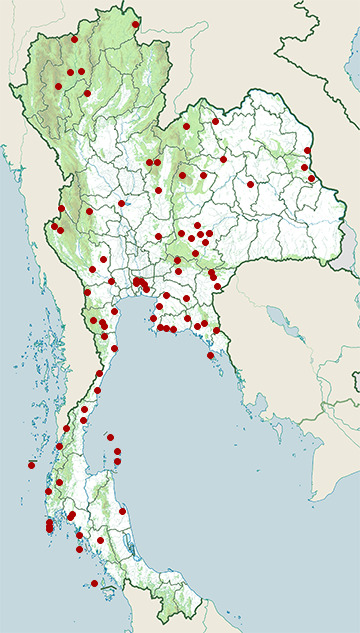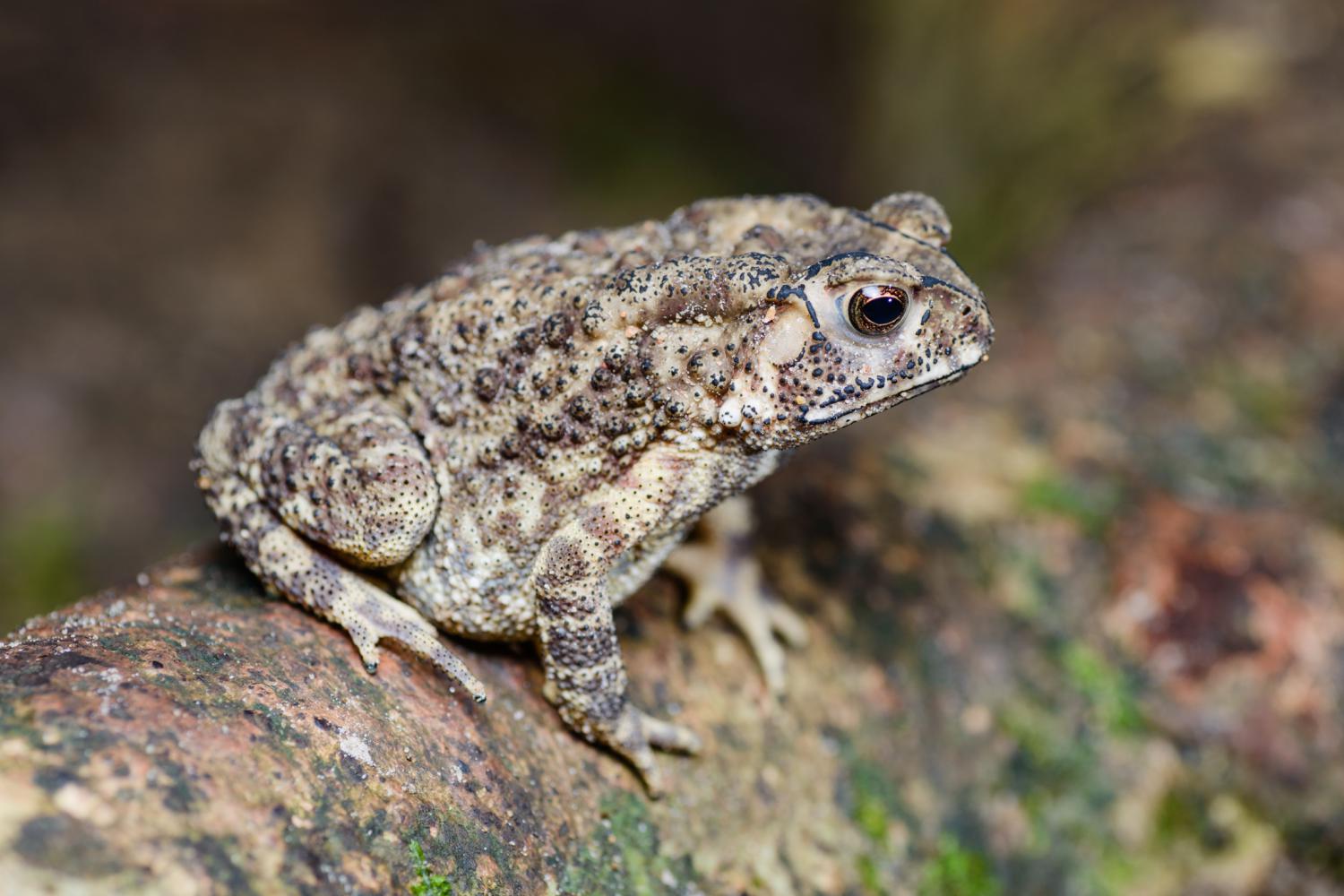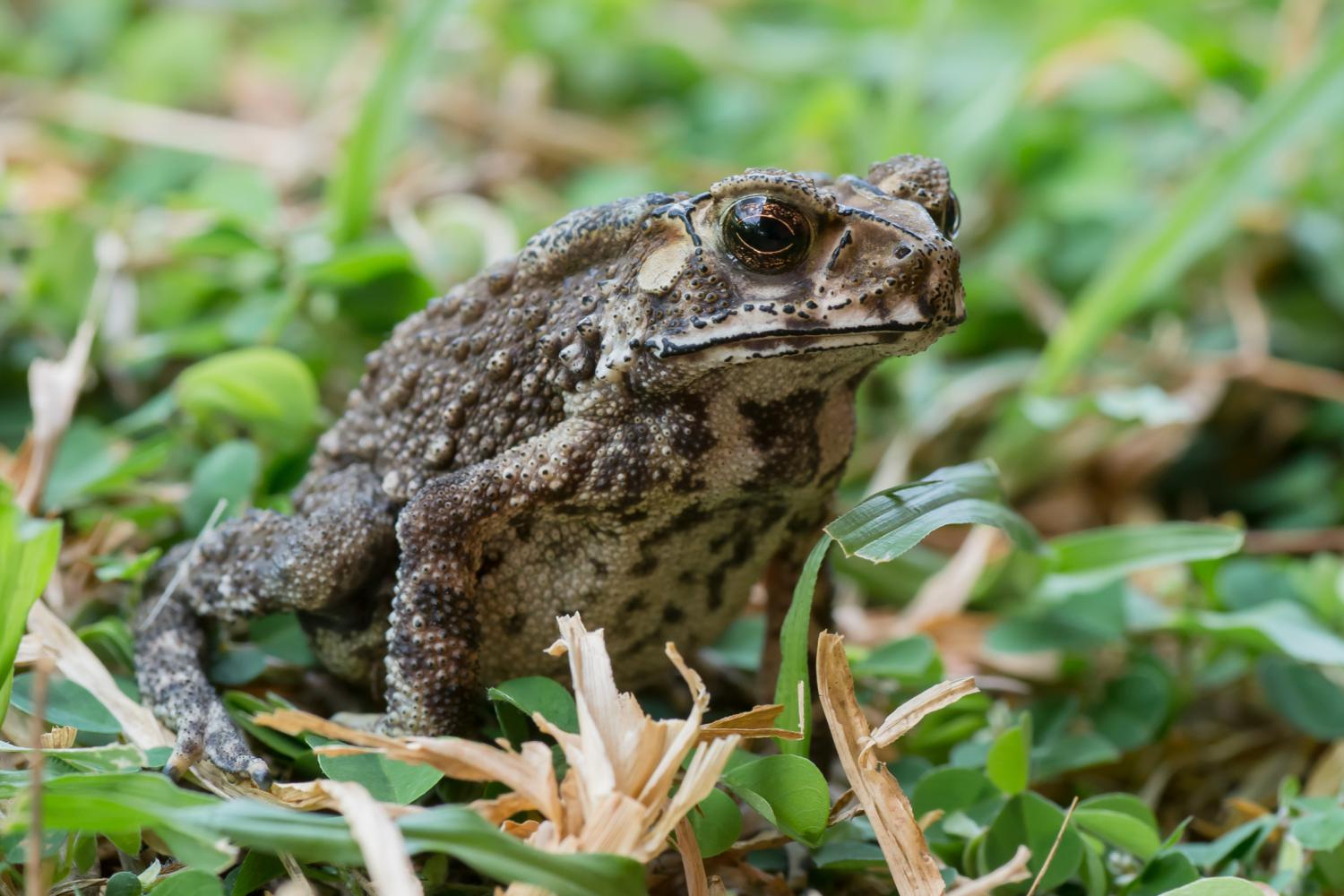Species of Thailand
Black-spined toad
Duttaphrynus melanostictus
Johann Gottlob Theaenus Schneider, 1799
In Thai: คางคกบ้าน
Duttaphrynus melanostictus is commonly called Asian common toad, Asian black-spined toad, Asian toad, black-spectacled toad, common Sunda toad, and Javanese toad. It is probably a complex of more than one true toad species that is widely distributed in South and Southeast Asia.
The species grows to about 20 cm long. Asian common toads breed during the monsoon, and their tadpoles are black. Young toads may be seen in large numbers after monsoon rains finish.
Characteristics
The top of the head has several bony ridges, along the edge of the snout (canthal ridge), in front of the eye (preorbital), above the eye (supraorbital), behind the eye (postorbital), and a short one between the eye and ear (orbitotympanic). The snout is short and blunt, and the space between the eyes is broader than the upper eyelid width. The ear drum or tympanum is very distinct and is at least as wide as two-thirds the diameter of the eye. The first finger is often longer than the second and the toes are at least half webbed. A warty tubercle is found just before the junction of the thigh and shank (subarticular tubercle) and two moderate ones are on the shank (metatarsus). No skin fold occurs along the tarsus. The "knee" (tarsometatarsal articulation) reaches the tympanum or the eye when the hind leg is held parallel along the side of the body. The dorsal side is covered with spiny warts. The parotoids are prominent, kidney-shaped, or elliptical and elongated, and secrete milky white Bufotoxin. The dorsal side is yellowish or brownish and the spines and ridges are black. The underside is unmarked or spotted. Males have a subgular vocal sac and black pads on the inner fingers that help in holding the female during copulation.
Ecology and behaviour
Asian common toads breed in still and slow-flowing rivers and temporary and permanent ponds and pools. Adults are terrestrial and may be found under ground cover such as rocks, leaf litter, and logs, and are also associated with human habitations. The larvae are found in still and slow-moving waterbodies.
They are often seen at night under street lamps, especially when winged termites swarm. They have been noted to feed on a wide range of invertebrates, including scorpions. Tadpoles grown in sibling groups metamorphosed faster than those that were kept in mixed groups. Tadpoles have been shown to be able to recognize kin. The 96h LC50 of commercial grade malathion for the tadpoles is 7.5 mg/L and sublethal levels of exposure can impair swimming.
Distribution and habitat
Asian common toads occur widely from northern Pakistan through Nepal, Bangladesh, India including the Andaman and Nicobar Islands, Sri Lanka, Myanmar, Thailand, Laos, Vietnam, Cambodia, southern China, Taiwan, Hong Kong and Macau to Malaysia, Singapore, and the Indonesian islands of Sumatra, Java, Borneo, Anambas and Natuna Islands. They have been recorded from sea level up to 1800 m -2 altitude, and live mostly in disturbed lowland habitats, from upper beaches and riverbanks to human-dominated agricultural and urban areas. They are uncommon in closed forests.
Madagascar
D. melanostictus arrived in Madagascar in 2011 at the port of Toamasina, and by 2014, was found in a 100 sqkm zone around that city.
Since its discovery on the east coast, a grave fear has developed that if the Asian toad is not eradicated from Madagascar and stronger quarantines are not developed to prevent reinvasion, it could have comparable impacts to those of cane toads in Australia. Because – like Australia's – Madagascar's native predators have been isolated from bufonids since the Jurassic, they are thought to lack resistance to toad toxins as found in natural varanid and snake predators of D. melanostictus in its native range.
One study analyzed the sequences of the Na+/K+-ATPase gene (sodium-potassium pump) in dozens of Malagasy species that may be feeding on D. melanostictus. It was found that all but one out of 77 species failed to show evidence of resistance to the toad toxin, which strongly suggests that these alien toads can significantly impact the native Malagasy animal life and contribute to the worsening biodiversity crisis in the region.
Nevertheless, evidence from one Australian species, the bluetongue lizard, Tiliqua scincoides, produces the possibility that some Malagasy animals do possess resistance to bufotenin because almost identical cardiac glycosides are produced by native plants of the genus Bryophyllum.
Wallacea and West Papua
D. melanostictus was introduced to the Indonesian island of Bali in 1958, Sulawesi in 1974, then subsequently to Ambon, Lombok, Sumba, Sumbawa, Timor and Indonesian New Guinea at Manokwari on the Vogelkop Peninsula. The species is now common at Sentani in far eastern Papua Province. The absence of resistance to toad toxins in native snake and varanid predators means that these species could suffer severe declines from the inadvertent spread of the Asian common toad via human traffic, and the currently near threatened New Guinea quoll is also almost certain to be further affected in the lower-altitude portion of its range.
An unwanted species in Australia
The Asian common toad has been detected in Australia at least four times since 2000.
The Asian common toad has been described as one of Australia's "10 most unwanted" species, and "potentially more damaging than the cane toad".
It may cause serious ecological problems due to "competition with native species, its potential to spread exotic parasites and pathogens and its toxicity". Like cane toads, the Asian common toad secretes toxins from glands in their backs to deter predators. These toxins would beyond reasonable doubt severely affect native predators, such as snakes, goannas and quolls.
The recent rate of incursions suggests a high likelihood of establishment in Australia. So, experts are calling for the Australian government to develop a "high-priority contingency plan" that includes stronger environmental quarantine and surveillance strategies.
This article uses material from Wikipedia released under the Creative Commons Attribution-Share-Alike Licence 3.0. Eventual photos shown in this page may or may not be from Wikipedia, please see the license details for photos in photo by-lines.
Scientific classification
- Kingdom
- Animalia
- Phylum
- Chordata
- Class
- Amphibia
- Order
- Anura
- Family
- Bufonidae
- Genus
- Duttaphrynus
- Species
- Duttaphrynus melanostictus
Common names
- English:
- Asian common toad
- Black-spined toad
- Black-spectacled toad
- Common sunda toad
- Javanese toad
- Asian Toad
- Thai:
- คางคกบ้าน
- คางขาก
Synonyms
- Ansonia kamblei, Ravichandran and Pillai (1990)
- Bufo melanostictus
Conservation status

Least Concern (IUCN3.1)
Photos
Please help us review our species pages if wrong photos are used or any other details in the page is wrong. We can be reached via our contact us page.
Range Map

- Amphawa District, Samut Songkhram
- Aranyaprathet District, Sa Kaeo
- Ban Chang District, Rayong
- Ban Dan Lan Hoi District, Sukhothai
- Ban Dung District, Udon Thani
- Ban Kha District, Ratchaburi
- Ban Laem District, Phetchaburi
- Ban Na San District, Surat Thani
- Ban Phaeo District, Samut Sakhon
- Ban Phai District, Khon Kaen
- Ban Phue District, Udon Thani
- Ban Pong District, Ratchaburi
- Ban Rai District, Uthai Thani
- Bang Bo District, Samut Prakan
- Bang Kaeo District, Phatthalung
- Bang Khen District, Bangkok
- Bang Khla District, Chachoengsao
- Bang Khonthi District, Samut Songkhram
- Bang Lamung District, Chonburi
- Bang Pahan District, Phra Nakhon Si Ayutthaya
- Bang Phlat District, Bangkok
- Bang Phli District, Samut Prakan
- Bang Rachan District, Sing Buri
- Bang Saphan District, Prachuap Khiri Khan
- Bangkok Province
- Betong District, Yala
- Bo Rai District, Trat
- Borabue District, Maha Sarakham
- Cha-Am District, Phetchaburi
- Chai Badan District, Lopburi
- Chaiyo District, Ang Thong
- Chaloem Phra Kiat District, Nakhon Ratchasima
- Chaloem Phra Kiat District, Nakhon Si Thammarat
- Chaloem Phra Kiat District, Saraburi
- Chatuchak District, Bangkok
- Chawang District, Nakhon Si Thammarat
- Chiang Dao Wildlife Sanctuary
- Chiang Khan District, Loei
- Chiang Saen District, Chiang Rai
- Chok Chai District, Nakhon Ratchasima
- Chom Phra District, Surin
- Chom Thong District, Chiang Mai
- Dan Makham Tia District, Kanchanaburi
- Dan Sai District, Loei
- Det Udom District, Ubon Ratchathani
- Din Daeng District, Bangkok
- Doi Inthanon National Park
- Doi Khun Tan National Park
- Doi Phu Kha National Park
- Doi Saket District, Chiang Mai
- Doi Suthep - Pui National Park
- Don Tan District, Mukdahan
- Erawan National Park
- Hang Chat District, Lampang
- Hang Dong District, Chiang Mai
- Hat Yai District, Songkhla
- Hua Hin District, Prachuap Khiri Khan
- Hua Sai District, Nakhon Si Thammarat
- Huai Kha Khaeng Wildlife Sanctuary
- Huai Krachao District, Kanchanaburi
- Huai Yang Waterfall National Park
- Kaeng Khoi District, Saraburi
- Kaeng Khro District, Chaiyaphum
- Kaeng Krachan District, Phetchaburi
- Kaeng Krachan National Park
- Kamphaeng Saen District, Nakhon Pathom
- Kanchanadit District, Surat Thani
- Kantang District, Trang
- Kantharalak District, Sisaket
- Kantharawichai District, Maha Sarakham
- Kap Choeng District, Surin
- Kapo Waterfall Forest Park
- Kapong District, Phang Nga
- Kaset Sombun District, Chaiyaphum
- Kathu District, Phuket
- Khan Na Yao District, Bangkok
- Khanom District, Nakhon Si Thammarat
- Khao Chamao District, Rayong
- Khao Chamao - Khao Wong National Park
- Khao Khiao - Khao Chomphu Wildlife Sanctuary
- Khao Khitchakut National Park
- Khao Kho District, Phetchabun
- Khao Laem National Park
- Khao Luang National Park
- Khao Phanom Bencha National Park
- Khao Phra - Bang Khram Wildlife Sanctuary
- Khao Phra Thaeo Wildlife Sanctuary
- Khao Sam Roi Yot National Park
- Khao Sok National Park
- Khao Yai Da
- Khao Yai National Park
- Khlong Luang District, Pathum Thani
- Khlong Sam Wa District, Bangkok
- Khlong Thom District, Krabi
- Khlong Toei District, Bangkok
- Khok Sung District, Sa Kaeo
- Khon Buri District, Nakhon Ratchasima
- Khuan Khanun District, Phatthalung
- Khuan Niang District, Songkhla
- Khun Chae National Park
- Khura Buri District, Phang Nga
- Klaeng District, Rayong
- Ko Bulon Le
- Ko Chang District, Trat
- Ko Kut District, Trat
- Ko Lanta District, Krabi
- Ko Lanta National Park
- Ko Lipe
- Ko Pha Ngan
- Ko Phayam
- Ko Samet
- Ko Samui District, Surat Thani
- Ko Tao
- Ko Yao District, Phang Nga
- Kra Buri District, Ranong
- Kui Buri District, Prachuap Khiri Khan
- Kumphawapi District, Udon Thani
- Laem Son National Park
- Lan Sak District, Uthai Thani
- Laplae District, Uttaradit
- Lat Krabang District, Bangkok
- Lat Phrao District, Bangkok
- Lom Kao District, Phetchabun
- Mae Ai District, Chiang Mai
- Mae Chaem District, Chiang Mai
- Mae Chai District, Phayao
- Mae Chan District, Chiang Rai
- Mae Fa Luang District, Chiang Rai
- Mae Mo District, Lampang
- Mae On District, Chiang Mai
- Mae Rim District, Chiang Mai
- Mae Sot District, Tak
- Mae Wang District, Chiang Mai
- Maha Rat District, Phra Nakhon Si Ayutthaya
- Mancha Khiri District, Khon Kaen
- Mayo District, Pattani
- Min Buri District, Bangkok
- Mu Ko Phetra National Park
- Mu Ko Ranong National Park
- Muak Lek District, Saraburi
- Mueang Ang Thong District, Ang Thong
- Mueang Bueng Kan District, Bueng Kan
- Mueang Buriram District, Buriram
- Mueang Chaiyaphum District, Chaiyaphum
- Mueang Chiang Mai District, Chiang Mai
- Mueang Chiang Rai District, Chiang Rai
- Mueang Chumphon District, Chumphon
- Mueang Kanchanaburi District, Kanchanaburi
- Mueang Khon Kaen District, Khon Kaen
- Mueang Krabi District, Krabi
- Mueang Lampang District, Lampang
- Mueang Lamphun District, Lamphun
- Mueang Loei District, Loei
- Mueang Mae Hong Son District, Mae Hong Son
- Mueang Maha Sarakham District, Maha Sarakham
- Mueang Mukdahan District, Mukdahan
- Mueang Nakhon Nayok District, Nakhon Nayok
- Mueang Nakhon Pathom District, Nakhon Pathom
- Mueang Nakhon Ratchasima District, Nakhon Ratchasima
- Mueang Nakhon Sawan District, Nakhon Sawan
- Mueang Nakhon Si Thammarat District, Nakhon Si Thammarat
- Mueang Nan District, Nan
- Mueang Nong Khai District, Nong Khai
- Mueang Nonthaburi District, Nonthaburi
- Mueang Pathum Thani District, Pathum Thani
- Mueang Pattani District, Pattani
- Mueang Phang Nga District, Phang Nga
- Mueang Phatthalung District, Phatthalung
- Mueang Phetchaburi District, Phetchaburi
- Mueang Phichit District, Phichit
- Mueang Phitsanulok District, Phitsanulok
- Mueang Phuket District, Phuket
- Mueang Prachinburi District, Prachinburi
- Mueang Prachuap Khiri Khan District, Prachuap Khiri Khan
- Mueang Ranong District, Ranong
- Mueang Rayong District, Rayong
- Mueang Samut Sakhon District, Samut Sakhon
- Mueang Samut Songkhram District, Samut Songkhram
- Mueang Saraburi District, Saraburi
- Mueang Sing Buri District, Sing Buri
- Mueang Songkhla District, Songkhla
- Mueang Sukhothai District, Sukhothai
- Mueang Surat Thani District, Surat Thani
- Mueang Trang District, Trang
- Mueang Ubon Ratchathani District, Ubon Ratchathani
- Mueang Udon Thani District, Udon Thani
- Nakhon Chai Si District, Nakhon Pathom
- Nam Nao National Park
- Namtok Mae Surin National Park
- Namtok Si Khit National Park
- Nang Rong District, Buriram
- Non Din Daeng District, Buriram
- Non Thai District, Nakhon Ratchasima
- Nong Chik District, Pattani
- Nong Han District, Udon Thani
- Nong Phai District, Phetchabun
- Nong Song Hong District, Khon Kaen
- Nopphitam District, Nakhon Si Thammarat
- Ongkharak District, Nakhon Nayok
- Pai District, Mae Hong Son
- Pak Chong District, Nakhon Ratchasima
- Pak Kret District, Nonthaburi
- Pak Phanang District, Nakhon Si Thammarat
- Pakham District, Buriram
- Pang Mapha District, Mae Hong Son
- Pang Sida National Park
- Pathio District, Chumphon
- Pathum Ratchawongsa District, Amnat Charoen
- Pathum Wan District, Bangkok
- Pha Daeng National Park
- Phan Thong District, Chonburi
- Phanat Nikhom District, Chonburi
- Phang Khon District, Sakon Nakhon
- Phanom District, Surat Thani
- Phatthana Nikhom District, Lopburi
- Phayuha Khiri District, Nakhon Sawan
- Phimai District, Nakhon Ratchasima
- Phra Nakhon Si Ayutthaya District, Phra Nakhon Si Ayutthaya
- Phra Pradaeng District, Samut Prakan
- Phrao District, Chiang Mai
- Phu Khiao District, Chaiyaphum
- Phu Khiao Wildlife Sanctuary
- Phu Kradueng District, Loei
- Phu Pha Yon National Park
- Phu Ruea National Park
- Phu Suan Sai National Park
- Phu Wiang National Park
- Phuket Province
- Phutthamonthon District, Nakhon Pathom
- Pong Nam Ron District, Chanthaburi
- Prachantakham District, Prachinburi
- Prakhon Chai District, Buriram
- Pran Buri District, Prachuap Khiri Khan
- Ranot District, Songkhla
- Sahatsakhan District, Kalasin
- Sai Mai District, Bangkok
- Sai Yok District, Kanchanaburi
- Sai Yok National Park
- Sakaerat Environmental Research Station
- San Kamphaeng District, Chiang Mai
- San Pa Tong District, Chiang Mai
- Sangkhla Buri District, Kanchanaburi
- Saphan Sung District, Bangkok
- Saraphi District, Chiang Mai
- Sathing Phra District, Songkhla
- Sathon District, Bangkok
- Sattahip District, Chonburi
- Sawang Daen Din District, Sakon Nakhon
- Seka District, Bueng Kan
- Si Mueang Mai District, Ubon Ratchathani
- Si Racha District, Chonburi
- Si Satchanalai National Park
- Si Songkhram District, Nakhon Phanom
- Sichon District, Nakhon Si Thammarat
- Sikhio District, Nakhon Ratchasima
- Singhanakhon District, Songkhla
- Sirindhorn District, Ubon Ratchathani
- Soeng Sang District, Nakhon Ratchasima
- Song Phi Nong District, Suphan Buri
- Sri Nakarin Dam National Park
- Su-ngai Kolok District, Narathiwat
- Suan Phueng District, Ratchaburi
- Sung Noen District, Nakhon Ratchasima
- Surin Islands
- Suwannakhuha District, Nong Bua Lamphu
- Tak Bai District, Narathiwat
- Takua Pa District, Phang Nga
- Takua Thung District, Phang Nga
- Tarutao National Marine Park
- Tha Chang District, Sing Buri
- Tha Luang District, Lopburi
- Tha Mai District, Chanthaburi
- Tha Maka District, Kanchanaburi
- Tha Muang District, Kanchanaburi
- Tha Sala District, Nakhon Si Thammarat
- Tha Takiap District, Chachoengsao
- Tha Yang District, Phetchaburi
- Thalang District, Phuket
- Thale Ban National Park
- Than To District, Yala
- That Phanom District, Nakhon Phanom
- Thawi Watthana District, Bangkok
- Thep Sathit District, Chaiyaphum
- Thepha District, Songkhla
- Thong Pha Phum National Park
- Thung Salaeng Luang National Park
- Thung Song District, Nakhon Si Thammarat
- Thung Wa District, Satun
- Thung Yai District, Nakhon Si Thammarat
- Thung Yai Naresuan Wildlife Sanctuary
- Ubolratana District, Khon Kaen
- Wang Chan District, Rayong
- Wang Chin District, Phrae
- Wang Hin District, Sisaket
- Wang Nam Khiao District, Nakhon Ratchasima
- Wang Noi District, Phra Nakhon Si Ayutthaya
- Wang Thong District, Phitsanulok
- Wapi Pathum District, Maha Sarakham
- Warin Chamrap District, Ubon Ratchathani
- Watthana Nakhon District, Sa Kaeo
- Wiang Kaen District, Chiang Rai
- Wiang Sa District, Nan
- Wihan Daeng District, Saraburi
- Wiset Chai Chan District, Ang Thong
- Yang Talat District, Kalasin






